
Postage stamps and postal history of Great Britain
Encyclopedia
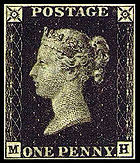
Postal history
Postal history is the study of postal systems and how they operate and, or, the study of postage stamps and covers and associated material illustrating historical episodes of postal systems...
from the United Kingdom
United Kingdom
The United Kingdom of Great Britain and Northern IrelandIn the United Kingdom and Dependencies, other languages have been officially recognised as legitimate autochthonous languages under the European Charter for Regional or Minority Languages...
and the postage stamp
Postage stamp
A postage stamp is a small piece of paper that is purchased and displayed on an item of mail as evidence of payment of postage. Typically, stamps are made from special paper, with a national designation and denomination on the face, and a gum adhesive on the reverse side...
s issued by that country and its various historical territories until the present day.
The postal history of the United Kingdom is notable in at least two respects; first, for the introduction of postage stamps in 1840, and secondly for the establishment of an efficient postal system throughout the British Empire
British Empire
The British Empire comprised the dominions, colonies, protectorates, mandates and other territories ruled or administered by the United Kingdom. It originated with the overseas colonies and trading posts established by England in the late 16th and early 17th centuries. At its height, it was the...
, laying the foundation of many national systems in existence today.
Early history
The story begins in the 12th century with Henry IHenry I of England
Henry I was the fourth son of William I of England. He succeeded his elder brother William II as King of England in 1100 and defeated his eldest brother, Robert Curthose, to become Duke of Normandy in 1106...
, who appointed messengers
Post riders
Post riders or postriders describes a horse and rider postal delivery system that existed at various times and various places throughout history...
to carry letters for the government. It is estimated that between 1100 and 1135, 4,500 letters were carried by these messengers. At this time, private individuals had to make their own arrangements. Henry III
Henry III of England
Henry III was the son and successor of John as King of England, reigning for 56 years from 1216 until his death. His contemporaries knew him as Henry of Winchester. He was the first child king in England since the reign of Æthelred the Unready...
provided uniform
Uniform
A uniform is a set of standard clothing worn by members of an organization while participating in that organization's activity. Modern uniforms are worn by armed forces and paramilitary organizations such as police, emergency services, security guards, in some workplaces and schools and by inmates...
s for the messengers, and Edward I
Edward I of England
Edward I , also known as Edward Longshanks and the Hammer of the Scots, was King of England from 1272 to 1307. The first son of Henry III, Edward was involved early in the political intrigues of his father's reign, which included an outright rebellion by the English barons...
instituted posting houses where the messengers could change horses. The reign of Edward II
Edward II of England
Edward II , called Edward of Caernarfon, was King of England from 1307 until he was deposed by his wife Isabella in January 1327. He was the sixth Plantagenet king, in a line that began with the reign of Henry II...
saw the first postal marking
Postal marking
A postal marking is any kind of annotation applied to a letter by a postal service. The most common types are postmarks and cancellations; almost every letter will have those. Less common types include forwarding addresses, routing annotations, warnings, postage due notices and explanations, such...
; handwritten notations saying "Haste, post haste".
Henry VIII
Henry VIII of England
Henry VIII was King of England from 21 April 1509 until his death. He was Lord, and later King, of Ireland, as well as continuing the nominal claim by the English monarchs to the Kingdom of France...
created the Royal Mail
Royal Mail
Royal Mail is the government-owned postal service in the United Kingdom. Royal Mail Holdings plc owns Royal Mail Group Limited, which in turn operates the brands Royal Mail and Parcelforce Worldwide...
in 1516, appointing Brian Tuke
Brian Tuke
Sir Brian Tuke , was the secretary of Henry VIII and Cardinal Wolsey. He became treasurer of the household.-Life:He may have been son of Richard Tuke and Agnes his wife, daughter of John Bland of Nottinghamshire...
as "Master of the Postes", while Elizabeth I
Elizabeth I of England
Elizabeth I was queen regnant of England and Ireland from 17 November 1558 until her death. Sometimes called The Virgin Queen, Gloriana, or Good Queen Bess, Elizabeth was the fifth and last monarch of the Tudor dynasty...
appointed Thomas Randolph
Thomas Randolph (diplomat)
Thomas Randolph was an English ambassador serving Elizabeth I of England. Most of his professional life he spent in Scotland at the courts of Mary, Queen of Scots, and her son James VI. While in Scotland, he was embroiled in marriage projects and several upheavals...
as "Chief Postmaster". Under Thomas Witherings
Thomas Witherings
Thomas Witherings was an English merchant and postal administrator who established the Royal Mail public letter service. He was a politician who sat in the House of Commons in 1640.-Early life:...
, chief postmaster under Charles I
Charles I of England
Charles I was King of England, King of Scotland, and King of Ireland from 27 March 1625 until his execution in 1649. Charles engaged in a struggle for power with the Parliament of England, attempting to obtain royal revenue whilst Parliament sought to curb his Royal prerogative which Charles...
, the Royal Mail was made available to the public (1635), with a regular system of post road
Post road
For other uses, see Post Road .A post road is a road designated for the transportation of postal mail. In past centuries only major towns had a post house, and the roads used by post riders or mail coaches to carry mail among them were particularly important ones or, due to the special attention...
s, houses, and staff. From this time through to the postal reforms of 1839 - 1840 it was most common for the recipient to pay the postage, although it was possible to prepay the charge at the time of sending.
In 1661, Charles II
Charles II of England
Charles II was monarch of the three kingdoms of England, Scotland, and Ireland.Charles II's father, King Charles I, was executed at Whitehall on 30 January 1649, at the climax of the English Civil War...
made Henry Bishop
Henry Bishop (postmaster general)
Henry Bishop, , also spelt Bishopp and Bisshopp, from Henfield in Sussex, England was a Postmaster General of England and inventor of the first postmark used on mail.-Postmaster General:...
the first Postmaster General
United Kingdom Postmaster General
The Postmaster General of the United Kingdom is a defunct Cabinet-level ministerial position in HM Government. Aside from maintaining the postal system, the Telegraph Act of 1868 established the Postmaster General's right to exclusively maintain electric telegraphs...
(PMG). In answer to customer complaints about delayed letters, Bishop introduced the Bishop mark, a small circle with month and day inside, applied at London
London
London is the capital city of :England and the :United Kingdom, the largest metropolitan area in the United Kingdom, and the largest urban zone in the European Union by most measures. Located on the River Thames, London has been a major settlement for two millennia, its history going back to its...
, in the General Post office and the Foreign section, and soon after adopted in Scotland, (Edinburgh), and Ireland, (Dublin). In subsequent years, the postal system expanded from six roads to a network covering the country, and post office
Post office
A post office is a facility forming part of a postal system for the posting, receipt, sorting, handling, transmission or delivery of mail.Post offices offer mail-related services such as post office boxes, postage and packaging supplies...
s were set up in both large and small towns, each of which had its own postmark
Postmark
thumb|USS TexasA postmark is a postal marking made on a letter, package, postcard or the like indicating the date and time that the item was delivered into the care of the postal service...
.
In 1680 William Dockwra
William Dockwra
William Dockwra was an English merchant who along with his partner Robert Murry created the first Penny Post in London in 1680. In latter 17th century London there was no official postal system for mail delivery within the city of London and its suburbs. Dockwra's London Penny Post was a mail...
established the London Penny Post
London Penny Post
The London Penny Post was a premier postal system whose function was to deliver mail within London and its immediate suburbs for the modest sum of one penny. The Penny Post was established in 1680 by William Dockwra and his business partner, Robert Murray...
, a mail delivery system that delivered letters and parcels weighing up to one pound within the city of london and some of its immediate suburbs for the sum of one penny.
Note on British currency
The unit of currency is the pound sterling. Its symbol is £, a stylised 'L' that represents the Latin word for pound, libra. Until February 1971, it was divided into twenty shillingShilling
The shilling is a unit of currency used in some current and former British Commonwealth countries. The word shilling comes from scilling, an accounting term that dates back to Anglo-Saxon times where it was deemed to be the value of a cow in Kent or a sheep elsewhere. The word is thought to derive...
s (20s. or 20/-) the / derives from the old long s. both symbols stand for its Latin name solidus
Solidus
Solidus may refer to:*Solidus , the "⁄" grammatical punctuation character, also used in mathematics*Slash a sign, "/" used as a punctuation mark and for various other purposes...
. Each shilling was divided into twelve pence 12d. The d represents denarius
Denarius
In the Roman currency system, the denarius was a small silver coin first minted in 211 BC. It was the most common coin produced for circulation but was slowly debased until its replacement by the antoninianus...
, the Latin word for a ten as piece. Since 1971, the pound remains but it is divided into a hundred of what were for a few years, called "new pence". Now they are "pence" for which the symbol is p. Thus, ignoring inflation, 2.4d. = 1p and 1/- = 5p.
Postage stamps
The Great Post Office Reform of 1839 and 1840 was championed by Rowland HillRowland Hill (postal reformer)
Sir Rowland Hill KCB, FRS was an English teacher, inventor and social reformer. He campaigned for a comprehensive reform of the postal system, based on the concept of penny postage and his solution of prepayment, facilitating the safe, speedy and cheap transfer of letters...
as a way to reverse the steady financial losses of the Post Office. Hill convinced Parliament to adopt the Uniform Fourpenny Post
Uniform Fourpenny Post
The Uniform Fourpenny Post was a short-lived uniform pre-paid letter rate in United Kingdom of Great Britain and Ireland that lasted for only 36 days from 5 December 1839 until 9 January 1840...
whereby a flat 4d per ½oz rate (equivalent to £1.18/kg for heavier items) was charged regardless of distance. The rate went into effect on 5 December 1839 but only lasted for 36 days. This was immediately successful, and on 10 January 1840 the Uniform Penny Post started, charging only 1d for prepaid letters and 2d if the fee was collected from the recipient. Fixed rates meant that it was practical to avoid handling money to send a letter by using an "adhesive label", and accordingly, on May 6, the Penny Black
Penny Black
The Penny Black was the world's first adhesive postage stamp used in a public postal system. It was issued in Britain on 1 May 1840, for official use from 6 May of that year....
became the world's first postage stamp
Postage stamp
A postage stamp is a small piece of paper that is purchased and displayed on an item of mail as evidence of payment of postage. Typically, stamps are made from special paper, with a national designation and denomination on the face, and a gum adhesive on the reverse side...
in use.
The stamp was originally for use only within the United Kingdom of Great Britain and Ireland
United Kingdom of Great Britain and Ireland
The United Kingdom of Great Britain and Ireland was the formal name of the United Kingdom during the period when what is now the Republic of Ireland formed a part of it....
and as such was in effect initially a local stamp. For this reason the name of the country was not included within the design, a situation which continued by agreement with foreign post offices, provided the sovereign's effigy appeared on the stamp. Envelopes sold with postage paid did not include this, so were marked with the country's name. In 1951, the special commemorative issue for the Festival of Britain included the name "Britain" incidentally. It could therefore be said that the name of the country then appeared for the first time on a stamp of the UK, although the word "British" had appeared on British Empire Exhibition commemorative stamps of 1924.
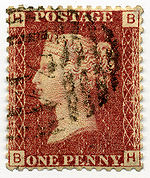
Penny Red
The Penny Red was a British postage stamp, issued in 1841. It succeeded the Penny Black and continued as the main type of postage stamp in the United Kingdom of Great Britain and Ireland until 1879, with only minor changes to the design during that time...
s continued in use for decades.
Victorian era
The Victorian age saw an explosion of experimentation. The inefficiency of using scissors to cut stamps from the sheet inspired trials with rouletting (the Archer Roulette), and then with perforationPerforation
A perforation is a small hole in a thin material or web. There is usually more than one perforation in an organized fashion, where all of the holes are called a perforation...
, which became standard practice in 1854. In 1847, the (octagonal) 1 shilling (£0.05) became the first of the British embossed postage stamps
British embossed postage stamps
The adhesive embossed postage stamps of the United Kingdom, issued during the reign of Queen Victoria between 1847 and 1854 exhibit four features which are unique to this issue:* The method of production of the dies used for the printing...
to be issued, followed by 10d stamps the following year, and 6d (£0.025) values in 1854.

De La Rue
De La Rue plc is a British security printing, papermaking and cash handling systems company headquartered in Basingstoke, Hampshire. It also has a factory on the Team Valley Trading Estate, Gateshead, and other facilities at Loughton, Essex and Bathford, Somerset...
, and subsequently became the standard type. ½d (halfpenny
Halfpenny Rose Red
The Halfpenny Rose Red, first issued on 1 October 1870, was the first halfpenny postage stamp issued in the United Kingdom.The halfpenny stamp was introduced following a reduction in the postal rate for newspapers and postcards and is notable for being the smallest UK postage stamp ever issued...
) and 1½d (penny halfpenny - pronounced pennyhaypny or threehaypence)
Three Halfpence Red
The Three Halfpence Red, first issued on 1 October 1870, was the first Three Halfpenny postage stamp issued in the United Kingdom.The 1½d stamp was line engraved and featured the bust of...
engraved stamps issued in 1870 were the last engraved types of Queen Victoria; the next would not appear until 1913. Surface-printed stamps of the 1860s and 1870s all used the same profile of Victoria, but a variety of frames, watermarks, and corner lettering.
A 5 shilling (abbreviated as 5/- or as 5s.) (£0.25) stamp first appeared in 1867, followed by 10 shilling (£0.50) and £1 values in 1878, culminating in a £5 stamp in 1882.
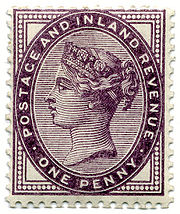
Perkins Bacon
Messrs. Perkins, Bacon & Co was a printer of books, bank notes and postage stamps, most notable for printing the Penny Black, the world's first adhesive postage stamps, in 1840.- Origins :...
printing contract. The new low values were also surface-printed: first was a penny stamp coloured Venetian red
Venetian red
Venetian red is a light and warm pigment that is a darker shade of scarlet, derived from nearly pure ferric oxide of the hematite type. Modern versions are frequently made with synthetic red iron oxide.-Venetian red:...
in a square frame, issued in 1880. However, the passage of the Customs and Inland Revenue Act 1881 necessitated new stamps valid also as revenue stamp
Revenue stamp
A revenue stamp, tax stamp or fiscal stamp is a adhesive label used to collect taxes or fees on documents, tobacco, alcoholic drinks, drugs and medicines, playing cards, hunting licenses, firearm registration, and many other things...
s, and so the Penny Lilac
Penny Lilac
The Penny Lilac was the basic penny postage stamp of Great Britain from its first issue on 12 July 1881 and was used until 1901. It superseded the short lived Penny Venetian Red because the Customs and Inland Revenue Act of 1881 necessitated new stamps that were also valid as revenue stamps, and so...
was issued in that year, inscribed "POSTAGE AND INLAND REVENUE". This stamp remained the standard letter stamp for the remainder of Victoria's reign, and vast quantities were printed. Later issues were inscribed POSTAGE & REVENUE which became the more familiar POSTAGE REVENUE.
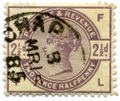
Fugitive pigments
Fugitive pigments are non-permanent pigments that lighten in a relatively short time when exposed to light. Fugitive pigments are present in types of paint, markers, inks etc., which are used for temporary applications...
s with the 'Lilac and Green Issue'
Queen Victoria Lilac and Green Issue
The postage stamps of the United Kingdom issued in 1883 and 1884 are known as the “Lilac and Green” issue because they were only printed in those two colours; lilac being used for the ½d, 2d, 2½d, 3d values and dull green for the 4d, 5d, 6d, 9d and 1s....
. These were rather plain designs, low values in lilac and high values in green, because those were the only colours available. They succeeded in their purpose - relatively few of the stamps survived usage, their colours fading away when soaked from the envelope - but they were not liked by the public.
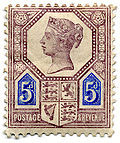
Early 20th century
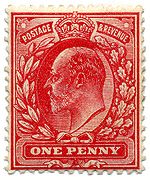
Edward VII of the United Kingdom
Edward VII was King of the United Kingdom and the British Dominions and Emperor of India from 22 January 1901 until his death in 1910...
succeeded to the throne, new stamps became necessary. The approach was very conservative however: most of the Jubilee frames were reused, and the image of the King was still a single profile. Edward's reign being fairly short, there were no major changes of design, but chalk-surfaced paper was introduced. (This type of paper
Postage stamp paper
Postage stamp paper is the foundation or substrate of the postage stamp to which the ink for the stamp's design is applied to one side and the adhesive is applied to the other...
can be detected by rubbing the surface with silver, which leaves a black mark.)

George V of the United Kingdom
George V was King of the United Kingdom and the British Dominions, and Emperor of India, from 6 May 1910 through the First World War until his death in 1936....
were innovative from the very first. The first issue made was of the ½d and 1d values, which were in the same colours as used in the previous reign. Although the main design feature remained the same – a central ellipse for the portrait, an ornamental frame, value tablet at the base and a crown at the top – a three quarter portrait was used for the first time. Subsequent designs reverted to the standard profile however.
The UK's first commemorative stamp
Commemorative stamp
A commemorative stamp is a postage stamp, often issued on a significant date such as an anniversary, to honor or commemorate a place, event or person. The subject of the commemorative stamp is usually spelled out in print, unlike definitive stamps which normally depict the subject along with the...
s were issued for the British Empire Exhibition
British Empire Exhibition
The British Empire Exhibition was a colonial exhibition held at Wembley, Middlesex in 1924 and 1925.-History:It was opened by King George V on St George's Day, 23 April 1924. The British Empire contained 58 countries at that time, and only Gambia and Gibraltar did not take part...
in 1924. The pair of large-format stamps featured a lion
Lion
The lion is one of the four big cats in the genus Panthera, and a member of the family Felidae. With some males exceeding 250 kg in weight, it is the second-largest living cat after the tiger...
in an imposing stance; they were issued twice, in 1924 and then in 1925, the stamps of each year being inscribed with the year of issue. A second set of commemoratives in 1929 marked the 9th Congress of the Universal Postal Union
Universal Postal Union
The Universal Postal Union is an international organization that coordinates postal policies among member nations, in addition to the worldwide postal system. The UPU contains four bodies consisting of the Congress, the Council of Administration , the Postal Operations Council and the...
(UPU), held in London that year.
Abdication and war
A set of four stamps was issued in 1936 for Edward VIIIEdward VIII of the United Kingdom
Edward VIII was King of the United Kingdom and the Dominions of the British Commonwealth, and Emperor of India, from 20 January to 11 December 1936.Before his accession to the throne, Edward was Prince of Wales and Duke of Cornwall and Rothesay...
before he abdicated. George VI
George VI of the United Kingdom
George VI was King of the United Kingdom and the Dominions of the British Commonwealth from 11 December 1936 until his death...
's coronation was marked with a commemorative: part of an omnibus issue
Omnibus issue
In philately, an omnibus issue is an issue of stamps by several countries with a common subject and which may share a uniform design. Omnibus issues have often been made by countries under common political control or groups of colonies due to the close co-operation required to produce the issue...
which included every colony in the Empire. New definitives featured a profile of the King on a solid colour background, based on a plaster cast by Edmund Dulac
Edmund Dulac
Edmund Dulac was a French book illustrator.-Early life and career:Born in Toulouse, France, he began his career by studying law at the University of Toulouse. He also studied art, switching to it full time after he became bored with law, and having won prizes at the Ecole des Beaux Arts...
. This was a precursor of the Machins three decades later: see below.
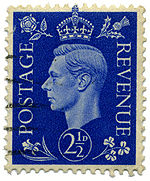
Silver Jubilee
A Silver Jubilee is a celebration held to mark a 25th anniversary. The anniversary celebrations can be of a wedding anniversary, ruling anniversary or anything that has completed a 25 year mark...
and the 1948 Summer Olympics
1948 Summer Olympics
The 1948 Summer Olympics, officially known as the Games of the XIV Olympiad, were an international multi-sport event which was held in London, England, United Kingdom. After a 12-year hiatus because of World War II, these were the first Summer Olympics since the 1936 Games in Berlin...
in 1948, and the 75th anniversary of the UPU, in 1949.
In 1950 the colours of all the low values were changed. 1951 saw a new series of high values (2s 6d, 5s, 10s, £1), and two commemoratives for the Festival of Britain
Festival of Britain
The Festival of Britain was a national exhibition in Britain in the summer of 1951. It was organised by the government to give Britons a feeling of recovery in the aftermath of war and to promote good quality design in the rebuilding of British towns and cities. The Festival's centrepiece was in...
.
Modern era
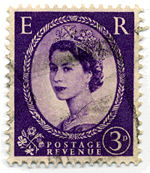
Wilding series
The Wildings were a series of definitive postage stamps featuring the Dorothy Wilding photographic portrait of Queen Elizabeth II that were in use between 1952 and 1967 until they were replaced by the Machin series.- History :...
, based on a portrait of Queen Elizabeth II by photographer Dorothy Wilding
Dorothy Wilding
Dorothy Wilding was a noted English society photographer from Gloucester. She wanted to become an actress or artist but this career was disallowed by her uncle, in whose family she lived, so she chose the art of photography which she started to learn from the age of sixteen.By 1929 she had already...
.
Wildings were used until 1967, when the Machin issues
Machin series
The Machin series of postage stamps is the main definitive stamp series in the United Kingdom, used since 5 June 1967. It is the second series to figure the image of Elizabeth II, replacing the Wilding series....
were introduced on 5 June. The Machin design is very simple, a profile of the Queen on a solid colour background, and very popular, still being the standard British stamp as of 2009. They have been printed in scores of different colours; in addition, decimalisation
Decimalisation
Decimal currency is the term used to describe any currency that is based on one basic unit of currency and a sub-unit which is a power of 10, most commonly 100....
required new denominations, and there have technical improvements in the printing process, resulting in literally hundreds of varieties known to specialists.
Design trends of British stamps
Up to the 1950s, British commemorative stamps were few and far between: most of the stamps were definitive issues in which the portrait of the reigning monarch was the dominant element. Even after commemorative stamps began to appear more often during the 1950s and early 1960s, the monarch's effigy was prominent, usually taking up a quarter to a third of the stamp's design, which limited flexibility and creativity. A change came in 1965 when the then Postmaster General Tony BennTony Benn
Anthony Neil Wedgwood "Tony" Benn, PC is a British Labour Party politician and a former MP and Cabinet Minister.His successful campaign to renounce his hereditary peerage was instrumental in the creation of the Peerage Act 1963...
issued new criteria for what could appear on stamps. Designer David Gentleman
David Gentleman
David Gentleman is an English artist-designer. He studied illustration at the Royal College of Art under Edward Bawden and John Nash. He has worked in various media - watercolour, lithography, wood engraving - and at scales ranging from the platform-length murals for Charing Cross underground...
wrote to Benn about alternative design approaches, suggesting the monarch's head be replaced by another national symbol, such as a Crown, Royal Cypher
Royal Cypher
In modern heraldry, a royal cypher is a monogram-like device of a country's reigning sovereign, typically consisting of the initials of the monarch's name and title, sometimes interwoven and often surmounted by a crown. In the case where such a cypher is used by an emperor or empress, it is called...
or words such as "Great Britain" or "UK". A compromise, a small silhouette of the Queen based on the coinage head of Mary Gillick
Mary Gillick
Mary Gillick was a sculptor best known for her effigy of Elizabeth II used on coinage in the United Kingdom and elsewhere from 1953 to 1967....
, was accepted and this has been the standard ever since for commemorative stamps. When the monarch's portrait is part of the stamp's main design (as for example in the case of issues commemorating the Queen's birthday), then the silhouette is not needed and does not appear. (An exception to this rule occurred in 2000 when a souvenir sheet issued in commemoration of the Queen Mother's 100th birthday included a stamp with a photograph of the Queen and the silhouette.)
Another trend is the growing use of stamps to commemorate events related to the present Royal Family. Up to Elizabeth II's accession in 1952 the only commemorative stamps to have been issued related to royal events were for George V
George V of the United Kingdom
George V was King of the United Kingdom and the British Dominions, and Emperor of India, from 6 May 1910 through the First World War until his death in 1936....
's Silver Jubilee in 1935, George VI
George VI of the United Kingdom
George VI was King of the United Kingdom and the Dominions of the British Commonwealth from 11 December 1936 until his death...
's coronation in 1937, and a 1948 issue to commemorate George VI's 25th wedding anniversary. Since 1952, however, stamps have been issued to commemorate many royal occasions:
- HM The Queen's silver (1977) and golden (2002) jubilees
- the 40th anniversary of her accession (in 1992)
- her coronation in 1953
- her silver, gold and diamond wedding anniversaries (in 1972, 1997 and 2007)
- the 25th and 50th anniversaries of her coronation (in 1978 and 2003)
- her 60th and 80th birthdays (in 1986 and 2006)
- the weddings of her sons and daughter (AnneAnne, Princess RoyalPrincess Anne, Princess Royal , is the only daughter of Elizabeth II and Prince Philip, Duke of Edinburgh...
's in 1973, CharlesCharles, Prince of WalesPrince Charles, Prince of Wales is the heir apparent and eldest son of Queen Elizabeth II and Prince Philip, Duke of Edinburgh. Since 1958 his major title has been His Royal Highness The Prince of Wales. In Scotland he is additionally known as The Duke of Rothesay...
' two weddings in 1981 and 2005, AndrewPrince Andrew, Duke of YorkPrince Andrew, Duke of York KG GCVO , is the second son, and third child of Queen Elizabeth II and Prince Philip, Duke of Edinburgh...
's in 1986, and EdwardPrince Edward, Earl of WessexPrince Edward, Earl of Wessex KG GCVO is the third son and fourth child of Elizabeth II and The Duke of Edinburgh...
's in 1999; Anne's second wedding in 1992 was not commemorated) - her mother's 80th, 90th and 100th birthdays (in 1980, 1990 and 2000)
- The Prince of WalesCharles, Prince of WalesPrince Charles, Prince of Wales is the heir apparent and eldest son of Queen Elizabeth II and Prince Philip, Duke of Edinburgh. Since 1958 his major title has been His Royal Highness The Prince of Wales. In Scotland he is additionally known as The Duke of Rothesay...
' investiture and its 25th anniversary (1969, 1994) - Prince William's 21st birthday in 2003.
In addition, memorial stamps have been issued after the deaths of Diana, Princess of Wales
Diana, Princess of Wales
Diana, Princess of Wales was the first wife of Charles, Prince of Wales, whom she married on 29 July 1981, and an international charity and fundraising figure, as well as a preeminent celebrity of the late 20th century...
(in 1998) and Queen Elizabeth The Queen Mother (in 2002).
With regard to previous monarchs, stamps were issued in 1987 to mark the 150th anniversary of Queen Victoria's accession, and in 1997 to mark the 450th anniversary of King Henry VIII
Henry VIII of England
Henry VIII was King of England from 21 April 1509 until his death. He was Lord, and later King, of Ireland, as well as continuing the nominal claim by the English monarchs to the Kingdom of France...
's death. Lately (2008-9) stamps have began to be issued featuring all of England's kings and queens, starting with the Lancaster
House of Lancaster
The House of Lancaster was a branch of the royal House of Plantagenet. It was one of the opposing factions involved in the Wars of the Roses, an intermittent civil war which affected England and Wales during the 15th century...
, York
House of York
The House of York was a branch of the English royal House of Plantagenet, three members of which became English kings in the late 15th century. The House of York was descended in the paternal line from Edmund of Langley, 1st Duke of York, the fourth surviving son of Edward III, but also represented...
and Tudor dynasties.
Regional issues
Beginning in 1958, regional issues were introduced in the Channel IslandsChannel Islands
The Channel Islands are an archipelago of British Crown Dependencies in the English Channel, off the French coast of Normandy. They include two separate bailiwicks: the Bailiwick of Guernsey and the Bailiwick of Jersey...
, the Isle of Man
Isle of Man
The Isle of Man , otherwise known simply as Mann , is a self-governing British Crown Dependency, located in the Irish Sea between the islands of Great Britain and Ireland, within the British Isles. The head of state is Queen Elizabeth II, who holds the title of Lord of Mann. The Lord of Mann is...
, Northern Ireland
Northern Ireland
Northern Ireland is one of the four countries of the United Kingdom. Situated in the north-east of the island of Ireland, it shares a border with the Republic of Ireland to the south and west...
, Scotland
Scotland
Scotland is a country that is part of the United Kingdom. Occupying the northern third of the island of Great Britain, it shares a border with England to the south and is bounded by the North Sea to the east, the Atlantic Ocean to the north and west, and the North Channel and Irish Sea to the...
, Wales
Wales
Wales is a country that is part of the United Kingdom and the island of Great Britain, bordered by England to its east and the Atlantic Ocean and Irish Sea to its west. It has a population of three million, and a total area of 20,779 km²...
. While these issues are only sold at post offices in the respective countries, the Northern Irish, Scottish and Welsh issues are valid throughout the United Kingdom. The Channel Islands (since 1969) and Isle of Man (since 1973) now issue their own stamps which are not valid anywhere else.
British postal services abroad
The United Kingdom has introduced postal services throughout the world and has often made use of British definitives bearing local overprints. The following is a full list of British postal services abroad and many of these will become the subject of independent articles in due course:- British post offices abroadBritish post offices abroadGreat Britain has introduced postal services throughout the world and has often made use of British definitives bearing local overprints. The following is a full list of British postal services abroad:* British Post Abroad** British post offices abroad...
- British post offices in AfricaBritish post offices in AfricaThe British post offices in Africa were a system of post offices set up by the United Kingdom to be used by its Middle East Forces and East Africa Forces in Africa during and after World War II.- Middle East Forces :...
various issues - Baghdad (British Occupation) 1917 only
- Bangkok (British Post Office)British post office in BangkokThe earliest recorded mail from Bangkok dates back only to 1836 when American missionary Dan Beach Bradley sent a letter to his father in a stampless cover...
1882 - 1885 - Batum (British Occupation) 1919 - 1920
- Beirut (British Post Office) 1906 only
- British post offices in the Turkish Empire 1885 - 1923
- British postal agencies in Eastern Arabia 1948 - 1966
- Bushire (British Occupation)Postage stamps of Bushire under British occupationBushehr or Bushire is a city on the southwestern coast of Iran, on the Persian Gulf. It is the chief seaport of the country and the administrative centre of Bushehr province.- History :...
1915 only - Cameroons (British Occupation) 1915 only
- China (British Post Offices)British post offices in ChinaThe British post offices in China were a system of post offices set up by the United Kingdom in various treaty ports of China in the late 19th and early 20th centuries....
1917 - 1930 - China (British Railway Administration) 1901 only
- Crete (British Post Offices) 1898 - 1899
- East Africa Forces 1943 - 1948
- Egypt (British Forces) 1932 - 1943
- Eritrea (British Administration) 1950 - 1952
- Eritrea (British Military Administration) 1948 - 1950
- German East Africa (British Occupation) 1917 only
- Iraq (British Occupation) 1918–1923
- Japan (British Commonwealth Occupation) 1946 - 1949
- Japan (British Post Offices) 1859 - 1879
- Long Island (British Occupation) 1916 only
- Madagascar (British Consular Mail) 1884 - 1895
- Mafia Island (British Occupation) 1915 - 1916
- Malaya (British Military Administration) 1945 - 1948
- Middle East Forces (MEF) 1942 - 1947
- Morocco AgenciesBritish post offices in MoroccoThe British post offices in Morocco, also known as the "Morocco Agencies", were a system of post offices operated by the United Kingdom in Morocco.-First office:...
1898 - 1957 - North Borneo (BMA) 1945 only
- Salonika (British Field Office) 1916 only
- Sarawak (BMA) 1945 only
- Somalia (British Administration) 1950 only
- Somalia (British Military Administration) 1948 - 1950
- Tangier 1927 - 1957
- Tripolitania (British Administration) 1950 - 1952
- Tripolitania (British Military Administration) 1948 - 1950
See also
- List of people on stamps of Great Britain
- List of British postage stamps
- Post Office (United Kingdom)
- London Penny PostLondon Penny PostThe London Penny Post was a premier postal system whose function was to deliver mail within London and its immediate suburbs for the modest sum of one penny. The Penny Post was established in 1680 by William Dockwra and his business partner, Robert Murray...
- The British Postal Museum & ArchiveThe British Postal Museum & ArchiveThe British Postal Museum & Archive is the leading resource for all aspects of the history of the British postal system. It operates three sites: The Royal Mail Archive at Mount Pleasant sorting office in Clerkenwell, London, a Museum Store in Loughton, Essex and The Museum of the Post Office in...
Further reading
- British Stamp Catalogues by Stanley Gibbons.
- Whitney, J.T. Collect British Postmarks. British Postmark Society, 1979.
- Great Britain, mostly Victorian stamps but up to Machins
- Wright, H.EH. E. WrightHastings Elwin Wright was an English philatelist who was one of the "Fathers of Philately" entered on the Roll of Distinguished Philatelists in 1921. He was a Civil Engineer by profession....
. & A.B. Creeke Jnr. A History of the Adhesive Stamps of the British Isles available for Postal and Telegraph Purposes. London: The Philatelic Society, London, 1899.

